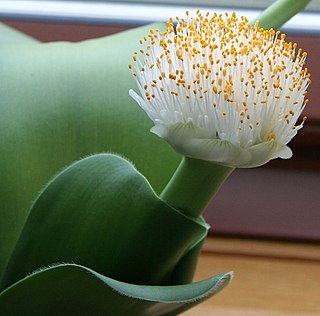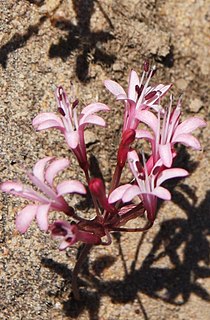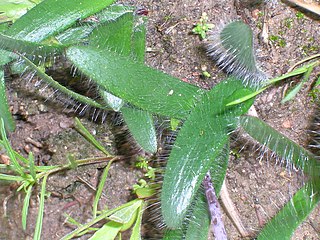
Brunsvigia is a genus of African flowering plants in the family Amaryllidaceae, subfamily Amaryllidoideae. It contains about 20 species native to southeastern and southern Africa from Tanzania to the Cape Provinces of South Africa.

Haemanthus is a Southern African genus of flowering plants in the family Amaryllidaceae, subfamily Amaryllidoideae. Members of the genus are known as blood lily and paintbrush lily. There are some 22 known species, native to South Africa, Botswana, Namibia, Lesotho and Eswatini. About 15 species occur in the winter rainfall region of Namaqualand and the Western Cape, the remainder being found in the summer rainfall region, with one species Haemanthus albiflos occurring in both regions.

Strumaria is a genus of African plants in Amaryllis family, subfamily Amaryllidoideae. The genus is known in nature only from South Africa, Lesotho and Namibia. Almost all species flower in the autumn and are cultivated as ornamental bulbous plants.

Grevillea floribunda, commonly known as seven dwarfs grevillea, is a species of flowering plant in the family Proteaceae and is endemic to eastern Australia. It is a spreading shrub with oblong to egg-shaped leaves with the narrower end towards the base and groups of six to twenty flowers covered with rusty brown hairs.

Hessea is a genus of bulb-forming plants in the Amaryllis family native to Namibia and South Africa. The genus name commemorates C. H. F. Hesse (1772–1832), who resided in Cape Town from 1800 to 1817.

Empodium is a genus of flowering plants in the family Hypoxidaceae, first described in 1866. It grows from a small corm which produces lance-shaped or pleated and sometimes hairy, star-shaped flowers and leaves with 10–30 centimetres (4–12 in) long in Autumn season. The genus is native to winter-rainfall areas in South Africa, Swaziland, Lesotho, and Namibia.
- Empodium elongatum(Nel) B.L.Burtt - Lesotho, Swaziland, Lesotho
- Empodium flexile(Nel) M.F.Thomps. ex Snijman - Cape Province
- Empodium gloriosum(Nel) B.L.Burtt - Cape Province
- Empodium monophyllum(Nel) B.L.Burtt - KwaZulu-Natal, Swaziland
- Empodium namaquensis(Baker) M.F.Thomps. - Cape Province
- Empodium plicatum(Thunb.) Garside - Cape Province
- Empodium veratrifolium(Willd.) M.F.Thomps. - Cape Province

Melaleuca incana subsp. tenella is a plant in the myrtle family Myrtaceae which is endemic to the south coast of Western Australia. It was formerly known as Melaleuca tenella Benth. but was reduced to a subspecies in 1998. It is similar to M. incana subsp. incana except in the form of the plant, the size and shape of its leaves, its flowering time and distribution.

Amaryllideae are a tribe of subfamily Amaryllidoideae. They are herbaceous monocot perennial flowering plants with a predominantly Southern African distribution, with the exception of the pantropical genus Crinum. They are generally treated as consisting of four subtribes. In addition to Crinum, other genera include Amaryllis, Boophone and Strumaria.

Strumariinae is one of four subtribes within the tribe Amaryllideae, found in southern Africa.

Dierdré "Dee" Anne Snijman is a South African botanist and plant taxonomist who is notable for studying and writing extensively on bulbs. She has described over 120 species and has written comprehensive works on South African flora. She received the 1997 Herbert Medal from the International Bulb Society for her research on Amaryllis.

Felicia tenella is an annual, sometimes biennial, herbaceous plant that may be slightly woody at its base, of 5–70 cm tall, that is assigned to the daisy family. The species is very variable in size and hairiness. Its branches may be erect or ascending, and the leaves are narrowly line-shaped, 2–5 cm long and about 1 mm (0.04 in) wide. The leaves have a callous tip, lack visible nerves, and are mostly rigidly ciliate. The flower heads sit individually at the tip of stalks, have an involucre of three whorls of bracts, and about thirty light blue ray florets surrounding many yellow disc florets. Four subspecies are recognised. The species naturally occurs in the Northern Cape and Western Cape provinces of South Africa.
Pauline Lesley Perry is a South African botanist, horticulturalist and plant collector.

Strumaria chaplinii is a species of bulbous flowering plant in the family Amaryllidaceae, native to south-west Cape Provinces. It was first described in 1944 as Hessea chaplinii.
Strumaria discifera is a species of flowering plant in the family Amaryllidaceae, native to west and south-west Cape Provinces. It was first described in 1992.

Strumaria gemmata is a species of flowering plant in the family Amaryllidaceae, native to the Cape Provinces and the Free State of South Africa. It was first described by John Bellenden Ker Gawler in 1814.
Strumaria massoniella is a species of flowering plant in the family Amaryllidaceae, native to the Cape Provinces of South Africa. It was first described in 1985 as Gemmaria massoniella. Its bulb is solitary. Like other members of the genus Strumaria it has star-shaped flowers. In the Northern Cape Province, it is found in sandy plains at an elevation of about 1,000 m (3,300 ft).
Strumaria salteri is a species of flowering plant in the family Amaryllidaceae, native to the Cape Provinces of South Africa, where it is found in seasonally moist sandstone outcrops. It has a loose inflorescence with pinkish flowers, the colour coming from the midribs of the tepals, similar to Strumaria gemmata. It was first described by Winsome Fanny Barker in 1944.

Strumaria truncata is a species of flowering plant in the family Amaryllidaceae, native to the Cape Provinces of South Africa. It is widely distributed in the northwest of the Cape Provinces, and the most common of the Strumaria species found there. It forms small clumps of bulbs which produce twisted leaves. Its flowers, which are pendulous, vary in colour from white to deep pink. The pink forms were once treated as a separate species, Strumaria rubella, and have also been called var. rubella. The species was first described by Nikolaus Joseph von Jacquin in 1792.

Strumaria watermeyeri is a species of flowering plant in the family Amaryllidaceae, native to the Cape Provinces of South Africa, where it is found in dry areas in the northwest. It is usually solitary, and has pink or white flowers. It was first described by Louisa Bolus in 1921.













